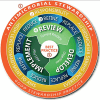Antimicrobial Stewardship in Veterinary Medicine
- PMID: 29916349
- PMCID: PMC11633576
- DOI: 10.1128/microbiolspec.ARBA-0023-2017
Antimicrobial Stewardship in Veterinary Medicine
Abstract
While antimicrobial resistance is already a public health crisis in human medicine, therapeutic failure in veterinary medicine due to antimicrobial resistance remains relatively uncommon. However, there are many pathways by which antimicrobial resistance determinants can travel between animals and humans: by close contact, through the food chain, or indirectly via the environment. Antimicrobial stewardship describes measures that can help mitigate the public health crisis and preserve the effectiveness of available antimicrobial agents. Antimicrobial stewardship programs have been principally developed, implemented, and studied in human hospitals but are beginning to be adapted for other applications in human medicine. Key learning from the experiences of antimicrobial stewardship programs in human medicine are summarized in this article-guiding the development of a stewardship framework suitable for adaptation and use in both companion animal and livestock practice. The antimicrobial stewardship program for veterinary use integrates infection prevention and control together with approaches emphasizing avoidance of antimicrobial agents. The 5R framework of continuous improvement that is described recognizes the importance of executive support; highly motivated organizations and teams (responsibility); the need to review the starting position, set objectives, and determine means of measuring progress and success; and a critical focus on reducing, replacing, and refining the use of antimicrobial agents. Significant issues that are currently the focus of intensive research include improved detection and diagnosis of infections, refined dosing regimens that are simultaneously effective while not selecting resistance, searches for alternatives to antimicrobial agents, and development of improved vaccines to enhance immunity and reduce disease.
Figures



References
-
- Rollin BE. 2005. Reflections on stewardship. Proceedings of the North American Veterinary Conference, January 8–12, 2005, Orlando, FL. http://www.ivis.org/proceedings/navc/2005/SAE/180.pdf?LA=1. [PubMed]
-
- O’Neill J (chair). 2016. The review on antimicrobial resistance. Tackling drug resistant infections globally: final report and recommendations. https://amr-review.org/sites/default/files/160525_Final%20paper_with%20c....
-
- O’Neill J (chair). 2015. The review on antimicrobial resistance. Antimicrobials in agriculture and the environment: reducing unnecessary use and waste. https://amr-review.org/sites/default/files/Antimicrobials%20in%20agricul....
Publication types
MeSH terms
Substances
LinkOut - more resources
Full Text Sources
Other Literature Sources

